Did you find this article helpful for what you want to achieve, learn, or to expand your possibilities? Share your feelings with our editorial team.


Jul 07, 2021
TECH & DESIGNWeight Reduction, Cooling Performance, and Reliability:Key Requirements for Air Mobility Motors
— Mechanism of motors for DENSO’s flying cars
What is the mechanism of the motor for flying cars, which DENSO is developing? At DENSO Tech Links Tokyo #11 organized by DENSO Corporation, employees involved in air mobility talked about how they are developing flying cars. In this section, Hirotsugu Yamada of Technology Development Dept. 2, Electric Components Eng. Div. introduces DENSO’s motor.
Contents of this article
Differences in the Usage of Automotive Motors and Air Mobility Motors
Hirotsugu Yamada: I’d like to talk about motors. I’ll explain air mobility motors and discuss their differences from automotive motors.
This table shows the usage differences between automotive motors and air mobility motors. The biggest difference is the weight of the electric propulsion unit, or EPU, as a percentage of the total.
The weight of an EPU includes both motors and inverters. As this table shows, an automotive EPU weighs about 50 kilograms, whereas an air mobility EPU weighs about 300 kilograms, which gives a very high percentage of the total weight.
A heavier EPU means a higher total weight. To extend the range of heavy aircraft, the battery capacity must be increased, but this increases the battery weight. Thus, the weight of an EPU is critical for aircraft.
A higher total weight reduces the payload in terms of the number of passengers and carrying capacity, reducing business competitiveness. For this reason, reducing the weight is a very important technical challenge.
Air mobility motors are driven continuously at a relatively high torque, so it is essential to efficiently remove the heat generated by the motors. Namely, the cooling performance is a major issue. I’ll come back to this topic later.
Safety is another critical issue in air mobility. When an abnormality occurs in a car, safety can be ensured by pulling off the road and stopping on the shoulder. However, an aircraft cannot be stopped, so it is essential to ensure safety, which means the EPU must be exceptionally reliable.
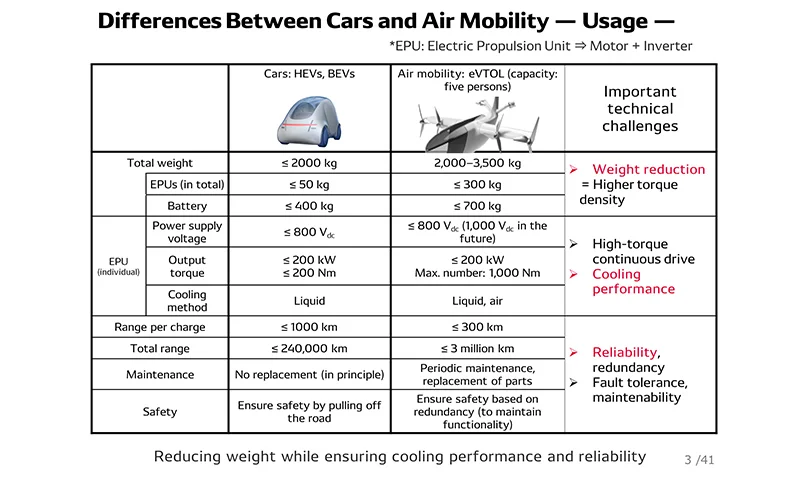
As I have stated, it is extremely important to attain weight reduction, cooling performance, and reliability of the motors.
Motor Drive Range
Next, I’d like to explain the motor drive range. The figure on the left shows the characteristics curve of an automotive motor. Driving on a steep slope requires high-torque motor characteristics in the steep slope range.
Meanwhile, high-speed driving requires high-rotational-speed range. This means that a wide drive range is required, with the low-torque drive range required most of the time in urban areas. From the viewpoint of characteristics, the efficiency in this range must be increased.
The figure on the right shows the characteristics curve required of an air mobility motor. In the case of eVTOL for air mobility, in particular, a specific operation pattern applies: taking off by hovering, flying by cruising, and landing by hovering. Thus, continuous drive is required in the relatively high-torque range.
In the case of single-failure operation, namely, when one of the propellers fails, the remaining motors must cover for the failed propeller. This requires higher output than when hovering.
Overall, high-torque continuous drive is an essential characteristic for an air mobility motor. As I mentioned earlier, it is necessary to efficiently remove the heat generated by motors while moving. The cooling performance is a key issue that must be resolved.
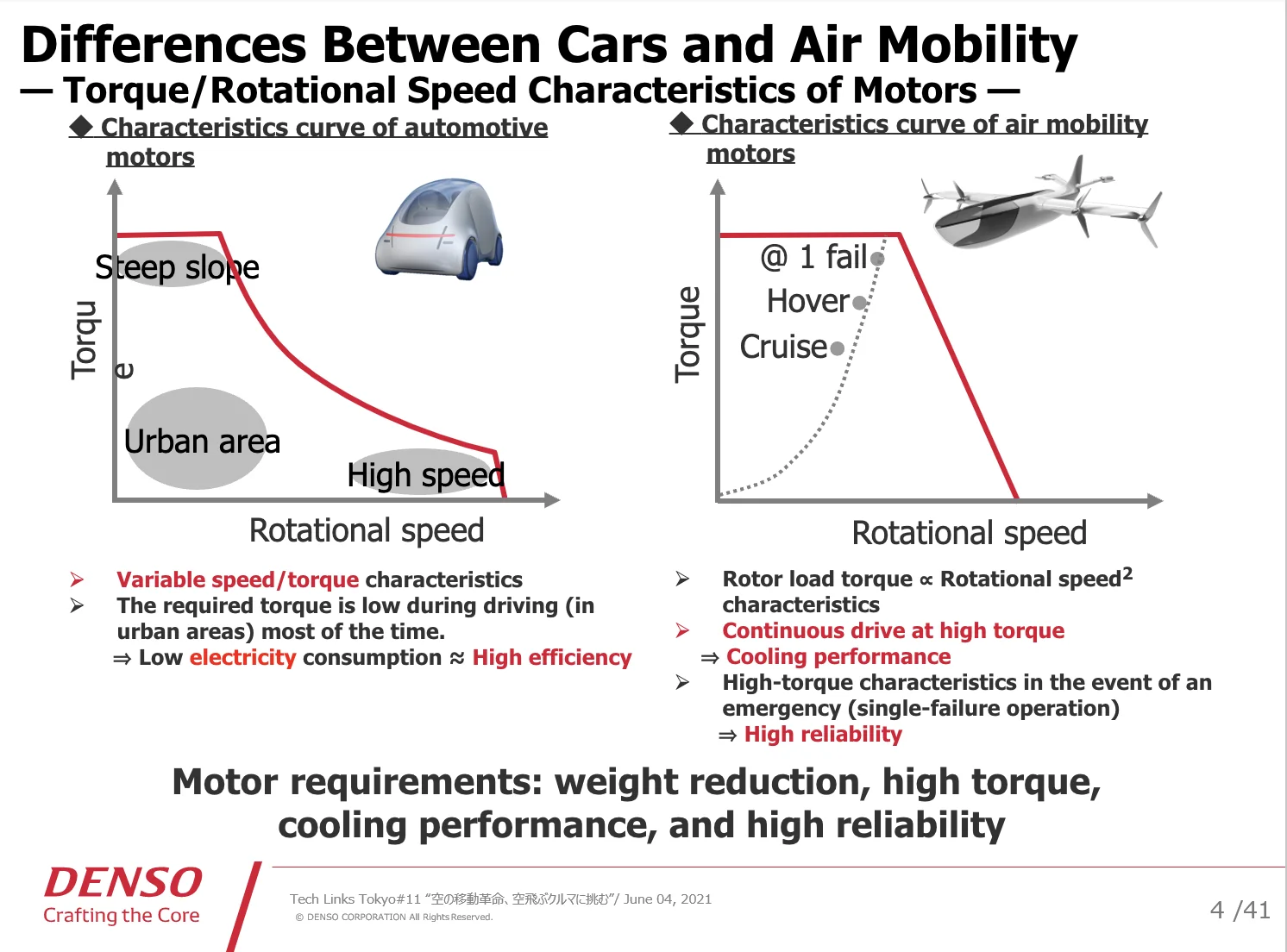
Motor Types and Magnetic Circuit Structures
Next, I’d like to explain the motor types and magnetic circuit structures. The figure on the left shows the magnetic circuit structure of an automotive motor. An IPM rotor is used to achieve the variable speed characteristics, which I explained earlier.
The rotor structure features magnets embedded in a rotor, which makes it easy to attain variable speed characteristics. Regarding the stator, a segment conductor (SC) winding is used to achieve a low-vibration and low-noise motor.
Meanwhile, the air mobility motor shown on the right does not require variable speed characteristics. It is required to drive in the relatively high-torque range. Thus, an SPM rotor with magnets attached on the surface is used because it can easily produce a high torque.
High-torque characteristics are achieved by increasing the number of magnets used and taking full advantage of the magnetic flux. The number of magnets is also increased to achieve multipolarization.
The magnetic flux can be increased by improving the rotor magnet orientation. High-density magnetic flux can be applied by using high-performance core materials, making it possible to reduce the weight of air mobility motors.
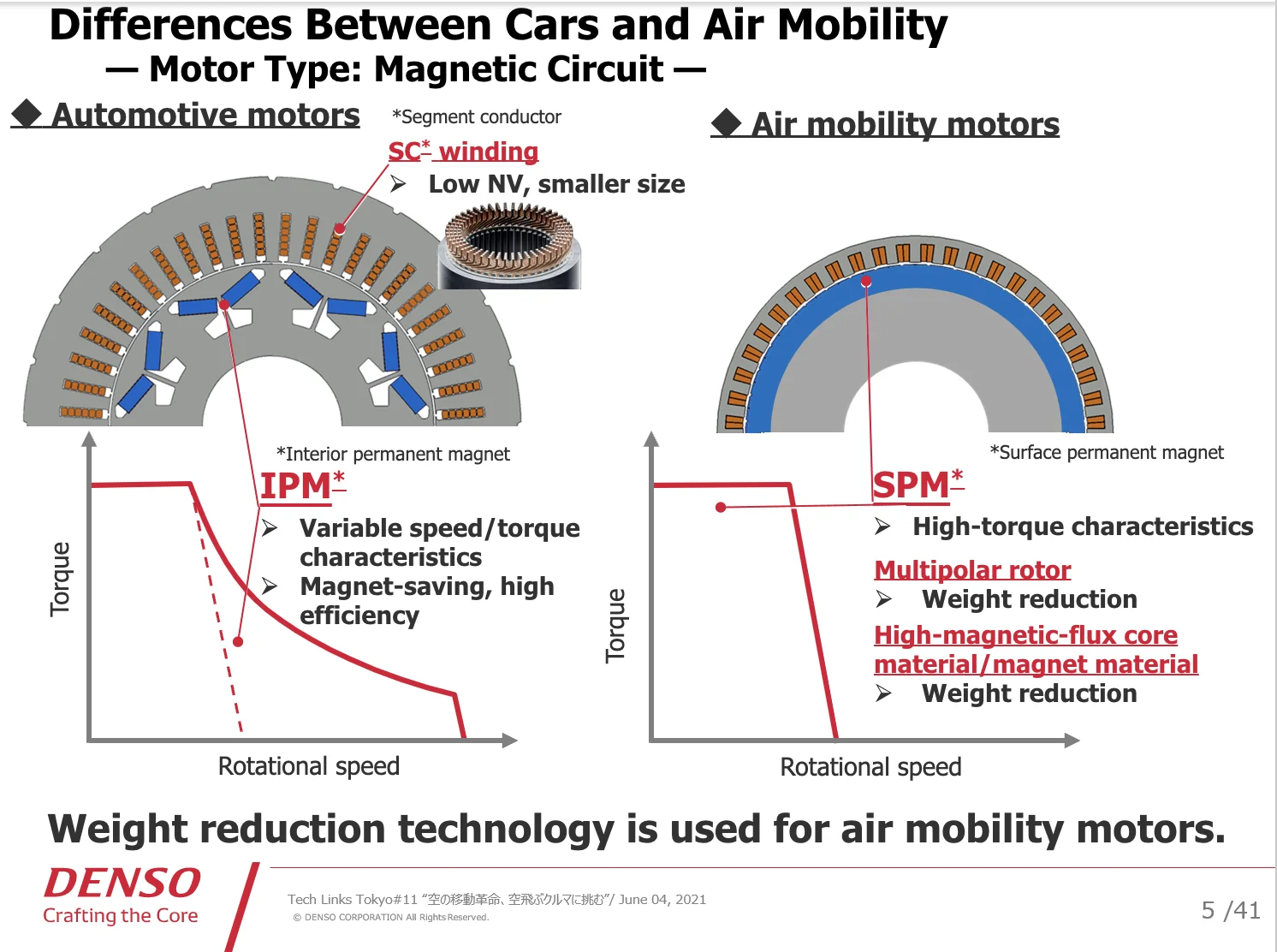
Motor Structure Materials
Next, I’d like to explain the motor structure materials. The figure at the top shows a cross section of a motor, and the table below shows the characteristics of the materials used for a motor. The structure encloses the magnetic circuit.
In the case of an air mobility motor, the weight ratio of the magnetic circuit and the structure is 50:50, so it is essential to reduce the weight of the structure.
The table below shows the physical properties of the materials. In general, steel, stainless steel, and aluminum are used for automotive motors due to cost constraints.
Regarding air mobility motors, the weight is reduced by using titanium, which is characterized by higher strength; metal composites, whose strength and thermal conductivity are enhanced; and CFRP, which offers both strength and light weight.

Motor Cooling Method
Now, I’d like to explain the cooling method. In ordinary cars, a motor is cooled either by water or oil. As shown in the figure on the left, a liquid-cooled motor requires auxiliary components, such as a pump for circulating water or oil, piping for the liquid, and a heat exchanger for releasing the removed heat into the atmosphere.
Addition of such auxiliary components is disadvantageous in terms of weight, and the larger number of components is another downside. In terms of reliability, a system with a low failure rate is required for each component.
Thus, air cooling is essential for air mobility motors, eliminating the need for the conventional cooling system. A simple system can be configured by installing cooling fins outside of the motor housing, which reduces the weight and improves safety.

Note that the heat generated by a 100 W-class motor is non-negligible, so heat radiation by air cooling must be carefully considered.
To achieve air cooling, we conduct a simulation analysis of the velocity distribution in the radial direction and the velocity change in the axial direction. We also analyze the velocity distribution downstream of a rotor to quantify the air velocity for a motor depending on the layout.
The contour map on the right shows the result of simulation analysis. We analyze the cooling air produced by a rotor and reflect it in the air-cooling design to increase the efficiency.
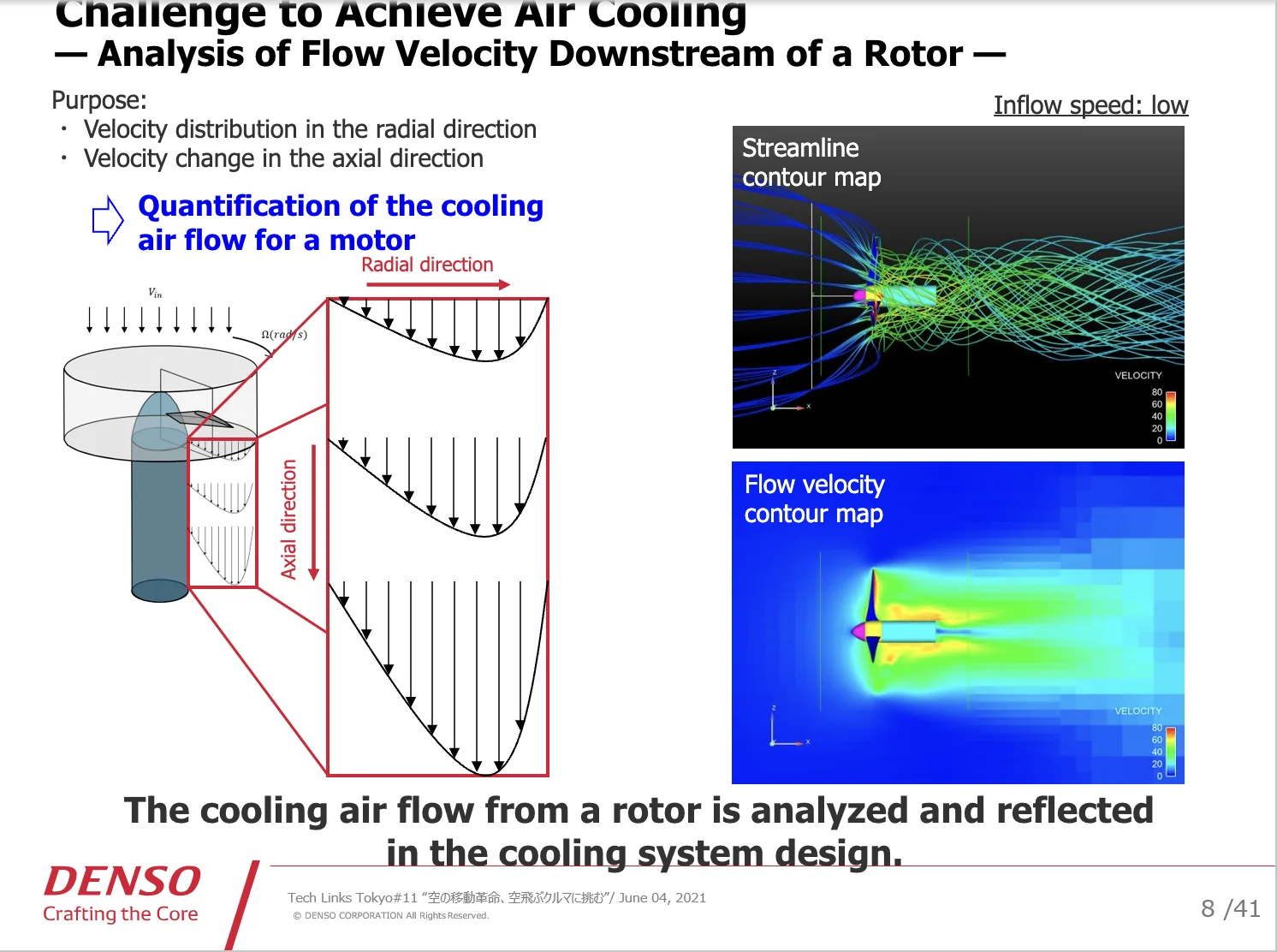
We are also developing a forced air cooling system. The figure on the left shows the analysis result of the flow velocity downstream of a rotor. The air inflow from the rotor varies significantly depending on the installation position and operating conditions of the motor.
The air inflow may also vary significantly depending on the propeller specifications. To minimize these environmental changes, we aim to equip a motor with a fan in order to generate a forced air flow on the side of the motor.
The figure on the right shows the simulation result of velocity distribution. We are concurrently studying a forced cooling method using a fan.
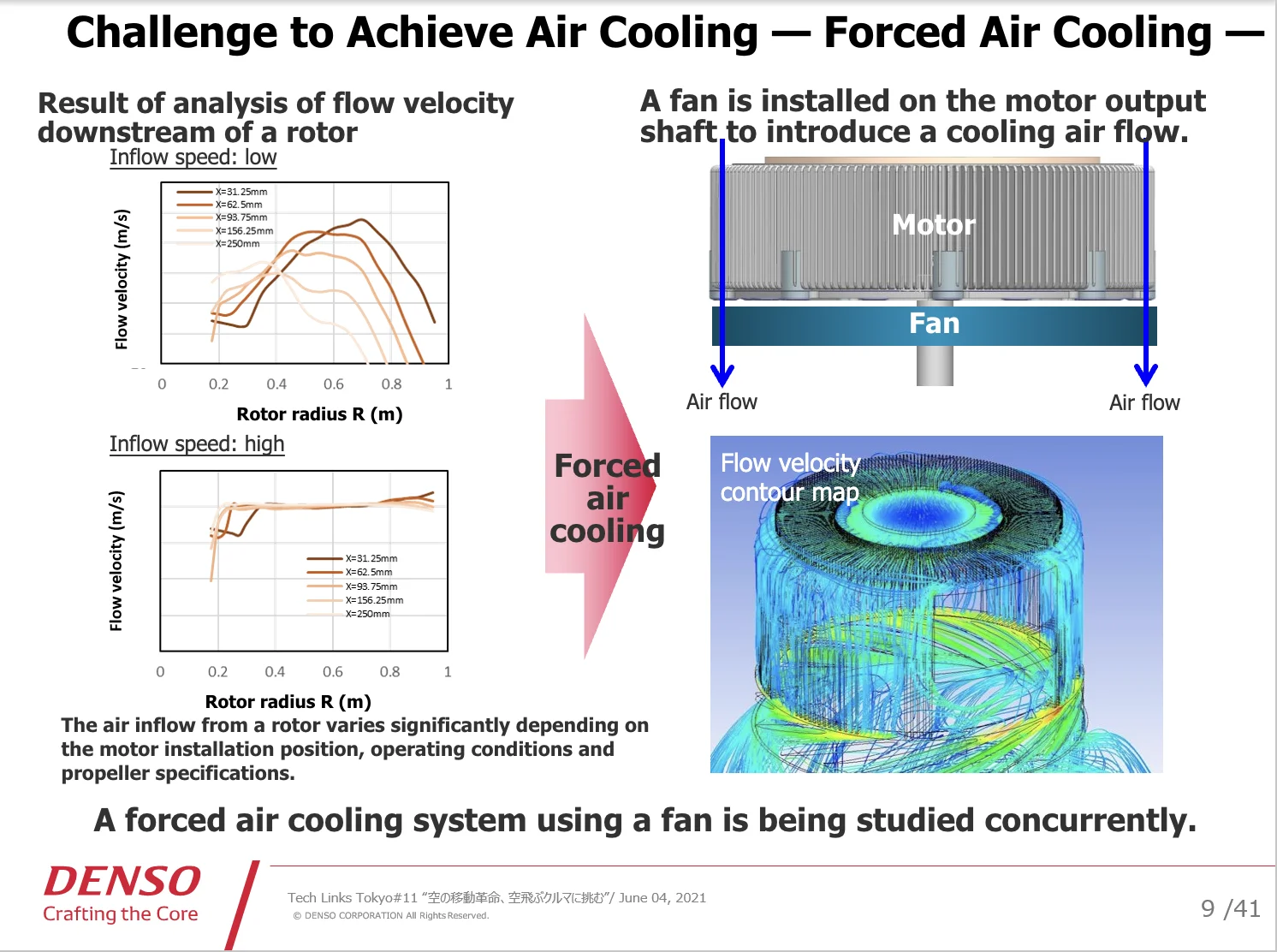
Status of Motor Evaluation at DENSO
Finally, I’d like to briefly explain the evaluation status of our prototype motor. The photo in the upper left shows the evaluation test of an air-cooled motor, which was installed on a bench. Multiple sensors were attached to monitor the heat distribution in the motor and to give feedback to improve the cooling performance.
The photo in the lower left shows a hood test. Fins around the motor were exposed to an air flow to measure the air velocity distribution. We are using these technologies to create a high-output-density motor.
I cannot tell you the specific value, but we are set to attain an output density more than triple that of conventional automotive motors. Tripling the output density means reducing the weight to one third.
We will keep developing these technologies to improve the output density of motors.
COMMENT
Changing your "Cant's" into "Cans"
Where Knowledge and People Gather.



